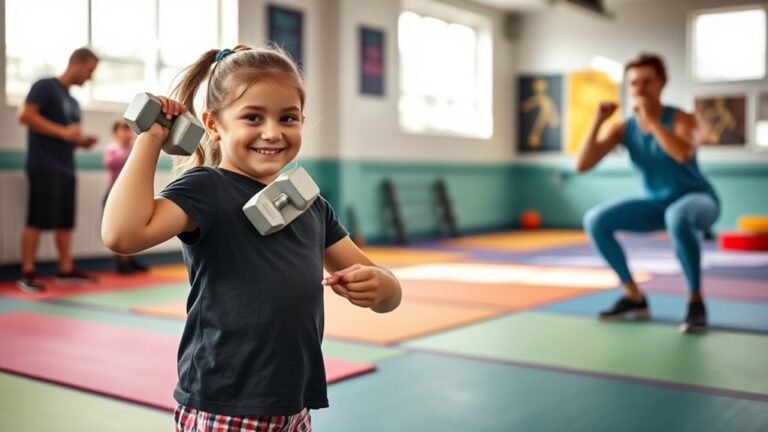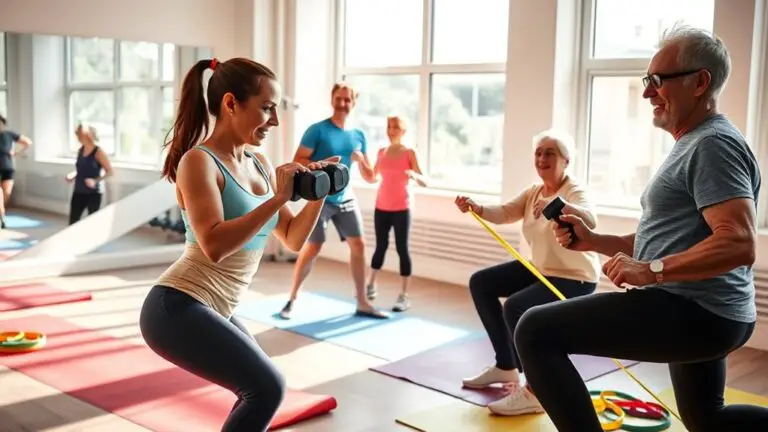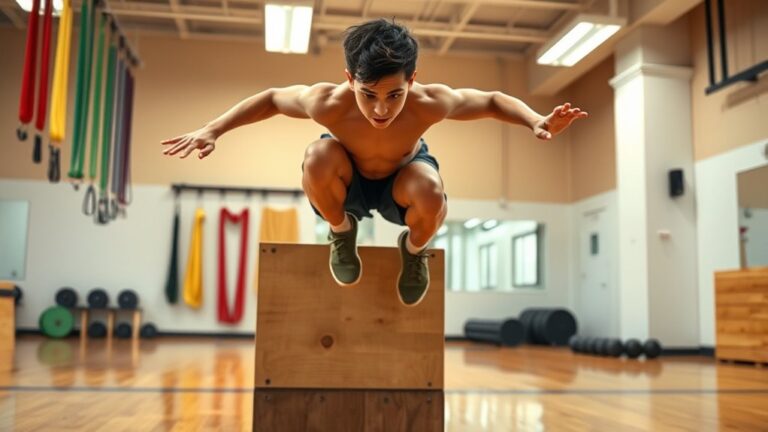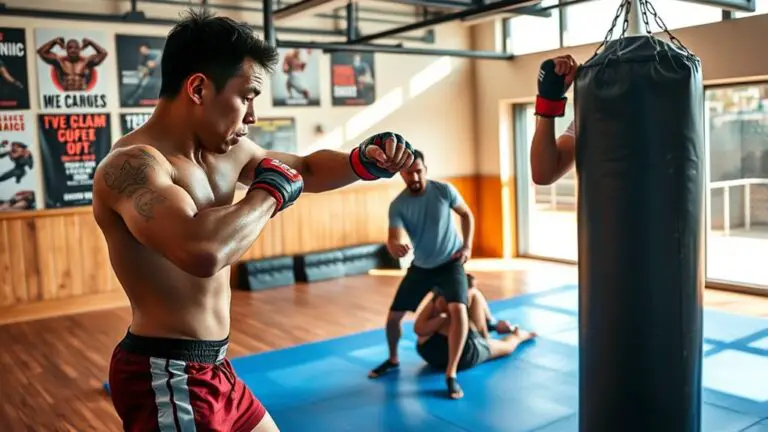How to Build a Strong Core Using Only Bodyweight Exercises
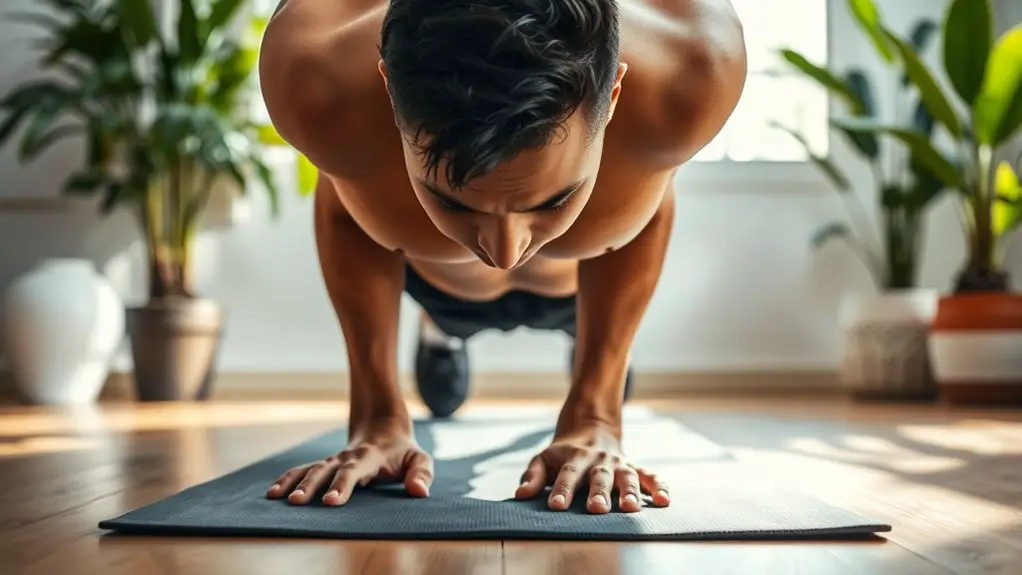
To build a strong core using only bodyweight exercises, focus on planks, side planks, and dynamic movements like Mountain Climbers and Bicycle Crunches. Engage in at least three sessions a week, targeting different core areas for balanced strength. Prioritize proper form and technique to prevent injury and maximize results. Consistency is key, so track your progress to stay motivated. Keep exploring the variety of exercises and techniques that can elevate your core workouts even further.
Understanding Core Anatomy
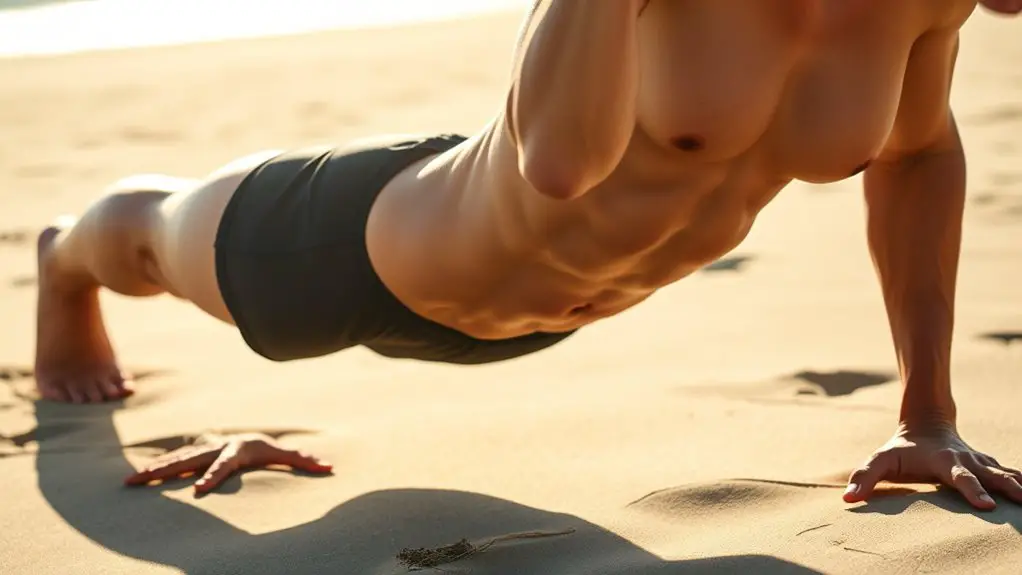
When it comes to building a strong core, understanding the anatomy of this essential muscle group is your first step. Your core isn’t just about the visible abs; it includes a complex network of core muscles that work together to provide stability and support. The major players are the rectus abdominis, transverse abdominis, internal and external obliques, and the multifidus. Each of these muscles contributes to overall core stability, helping you maintain balance and posture during various activities.
As you engage in bodyweight exercises, like planks or bridges, you’ll activate these muscles, enhancing their strength and coordination. This foundational knowledge empowers you to focus on proper form and technique, maximizing your workouts. By understanding how your core functions, you’ll not only improve your fitness but also reduce the risk of injury. So, immerse yourself, connect with your core, and embrace the journey to a stable and powerful body!
Benefits of a Strong Core
A strong core is essential for improving your balance and stability, helping you perform daily activities with ease. It also enhances your athletic performance, allowing you to excel in sports and physical activities. By focusing on core strength, you’re setting yourself up for success in both fitness and life.
Improved Balance and Stability
Though many might overlook it, a strong core is essential for improved balance and stability in everyday activities. When you engage in balance exercises and stability drills, you’ll notice how much easier it is to perform tasks like walking, standing, or even reaching for something on a high shelf. A well-developed core supports your spine and pelvis, allowing you to maintain proper posture and prevent falls. As you incorporate bodyweight exercises into your routine, you’ll enhance your core strength, leading to better coordination and control over your movements. This foundation not only boosts your confidence but also makes daily activities more enjoyable. So, start focusing on your core today, and you’ll reap the benefits of improved balance and stability!
Enhanced Athletic Performance
While many athletes focus on specific skills or techniques, enhancing your core strength can be a game-changer for your overall performance. A strong core stabilizes your body, allowing for better control during explosive movements, which is essential in sports like sprinting, basketball, and soccer. You’ll notice improved power transfer from your core to your limbs, making every jump, sprint, and throw more effective. Furthermore, with a solid core, your agility training will become more efficient. You’ll be able to change directions quickly and maintain balance, reducing the risk of injury. By committing to bodyweight exercises that target your core, you’re not just building strength; you’re also setting yourself up for a higher level of athletic performance. Keep pushing your limits!
Essential Bodyweight Exercises for Core Strength
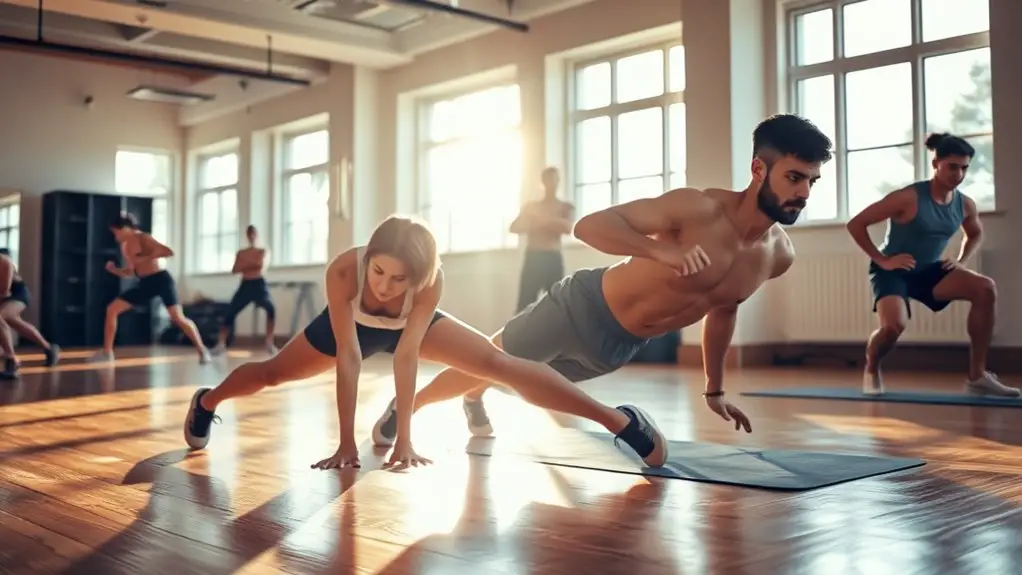
To build a powerful core, you’ll want to incorporate essential bodyweight exercises that challenge your stability and strength. Plank variations and dynamic core movements are key to enhancing your overall fitness and endurance. Let’s explore how these exercises can transform your core training routine.
Plank Variations
When it comes to building a strong core, incorporating various plank variations can elevate your workout routine and maximize results. Plank modifications, like the forearm plank or extended plank, can help you target different muscle groups while maintaining stability. Don’t forget about side planks; they’re fantastic for engaging your obliques and improving overall core strength. You can even try dynamic side planks, lifting your hips and reaching your arm overhead to add intensity. Remember, the key is to maintain proper form—keep your body in a straight line and engage your core throughout. By regularly integrating these plank variations into your workouts, you’ll not only build a strong core but also enhance your overall fitness level.
Dynamic Core Movements
Dynamic core movements are a powerful way to enhance your core strength and stability. By incorporating these exercises, you’ll engage dynamic movement patterns that challenge your entire core. Here are three essential bodyweight exercises to get you started:
- Mountain Climbers: This exercise combines cardio with core activation techniques, helping to build endurance and strength.
- Bicycle Crunches: These target your obliques and rectus abdominis, promoting rotational strength and stability.
- Plank to Push-Up: Shifting from a plank to a push-up engages multiple muscle groups, enhancing overall core functionality.
Incorporating these dynamic movements into your routine will not only improve your core strength but also enhance your athletic performance. Keep pushing your limits!
Creating a Balanced Core Workout Routine
A well-rounded core workout routine is essential for building strength and stability in your entire body. To create an effective routine, focus on exercises that target all areas of your core, including the front, sides, and back. Incorporate movements like planks, side planks, and leg raises to guarantee balanced core engagement.
Aim for a workout frequency of at least three times a week, allowing for recovery between sessions. This consistency will help you build endurance and strength over time. Remember to mix up your exercises to keep your routine fresh and challenging.
You can also add variations to increase intensity and engage different muscle fibers. Tracking your progress will motivate you to stay committed. By dedicating time to a balanced core workout, you’ll not only enhance your performance in other activities but also improve your overall posture and stability.
Tips for Proper Form and Technique
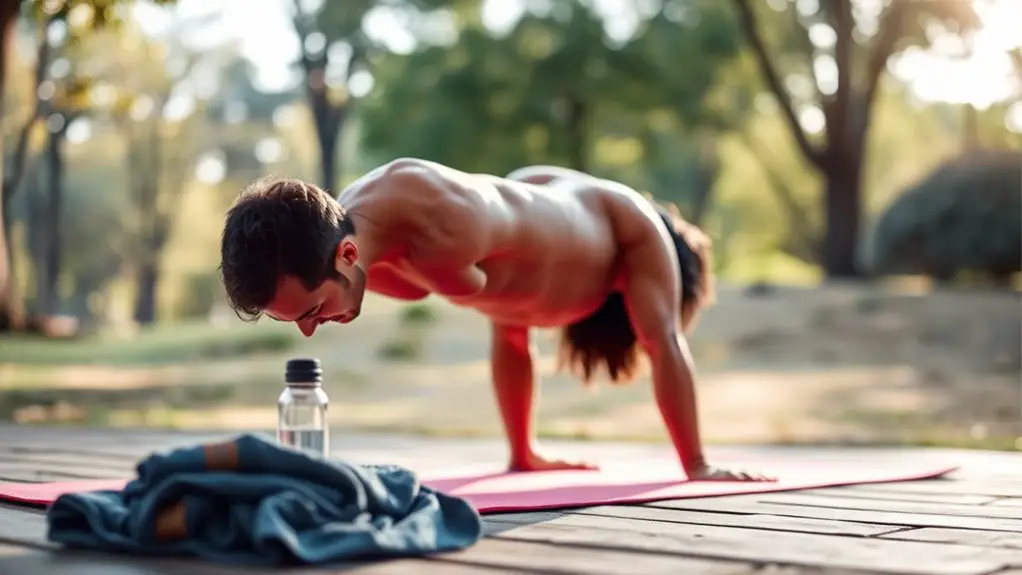
To maximize the benefits of your core workout routine, focusing on proper form and technique is key. Here are some tips to help you achieve that:
- Maintain Correct Posture: Keep your spine neutral and shoulders relaxed. Avoid overarching your back or slouching, as this can lead to injury and reduce effectiveness.
- Use Breathing Techniques: Inhale deeply through your nose and exhale through your mouth. Coordinating your breath with your movements helps stabilize your core and enhances endurance.
- Engage Your Core: Before starting any exercise, tighten your abdominal muscles as if preparing for a gentle punch. This engagement activates your core and guarantees you’re working the right muscles.
Progressing Your Bodyweight Core Exercises
While many bodyweight core exercises can effectively build strength, progressing them is essential for continued improvement and challenge. You can achieve core progression by incorporating exercise variations that increase difficulty or engage different muscle groups. Here are some ways to elevate your core workouts:
| Exercise | Variation |
|---|---|
| Plank | Plank with Shoulder Taps |
| Bicycle Crunch | Bicycle Crunch with Twist |
| Mountain Climbers | Slow Mountain Climbers |
| Side Plank | Side Plank with Leg Raise |
| Hollow Body Hold | Rocking Hollow Body Hold |
Incorporating Core Work Into Your Fitness Regimen
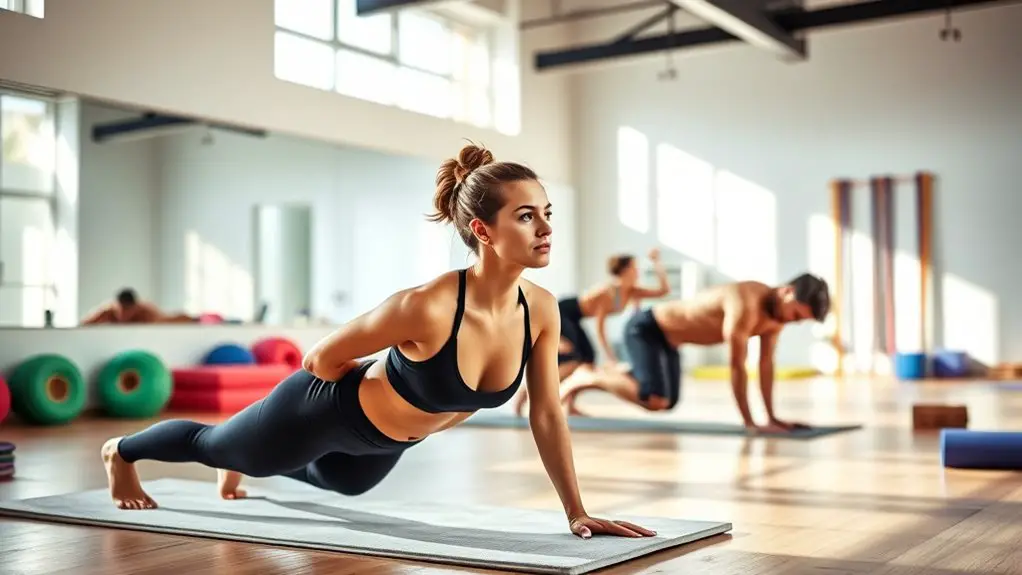
Progressing your bodyweight core exercises is just the beginning; integrating core work into your overall fitness regimen can amplify your results and enhance overall performance. A strong core supports every movement, helping you reach your fitness goals more efficiently. Here are three ways to incorporate core workouts into your routine:
- Warm-Up: Start your sessions with dynamic core exercises like planks or bicycle crunches to activate your muscles.
- Superset: Combine core exercises with other strength moves. For example, pair push-ups with leg raises to maximize your workout.
- Cool Down: End with static stretches that focus on your core, such as cobra or child’s pose, to promote flexibility and recovery.
Measuring Your Core Strength Progress
How do you know if your efforts in building core strength are paying off? One effective way is by incorporating core strength tests into your routine. These tests can include planks, side planks, or hollow holds, which measure your stability and endurance. Set improvement metrics, like timing yourself or increasing the number of repetitions, to track your progress over time.
You might also consider how everyday activities feel—are you lifting, bending, or twisting with more ease? This functional improvement is a significant indicator of core strength gains.
Additionally, maintain a journal to document your performance on these tests. Regularly reviewing this data will help you stay motivated and recognize your growth. Remember, consistency is essential; celebrate even small victories to keep pushing forward. By measuring your core strength, you’re not just building abs—you’re investing in a stronger, healthier you.
Frequently Asked Questions
Can I Build Core Strength Without Any Equipment?
Sure, you can definitely build core strength without any equipment. Imagine you’re like Sarah, who transformed her core using bodyweight routines at home. She incorporated plank variations, like side planks and plank jacks, into her daily workouts. By focusing on these exercises, she not only improved her strength but also increased stability and posture. So, get started with those planks and watch your core strength soar—no gym necessary!
How Often Should I Train My Core for Best Results?
To get the best results, aim to train your core about three to four times a week. This frequency allows your muscles to recover while still challenging them. Incorporating training variety is essential; mix exercises like planks, leg raises, and bicycle crunches to target different muscle groups. Don’t forget to listen to your body—rest when needed, and you’ll see improvements in strength and stability in no time! Keep pushing yourself!
Are There Any Age Restrictions for Bodyweight Core Exercises?
Age is just a number, like a river flowing steadily; it can carve paths of strength and resilience. There aren’t strict age restrictions for bodyweight core exercises. In fact, age benefits your wisdom, allowing you to adapt and modify exercises to suit your needs. Whether you’re young or young-at-heart, listen to your body and embrace modifications. This way, you can enjoy a strong core while respecting your unique journey through life.
What Should I Do if I Feel Pain During Exercises?
If you feel pain during exercises, it’s essential to listen to your body. Pain management starts with recognizing what’s causing discomfort. Consider exercise modifications; adjusting your technique or trying easier variations can help. Don’t push through pain—take a break and assess your limits. Remember, it’s about progress, not perfection. Stay motivated by focusing on the journey and finding alternatives that keep your workouts safe and effective. Your health is the priority!
How Long Will It Take to See Results in My Core Strength?
When it comes to core strength, patience is key. Timeframe expectations can vary widely due to individual differences in fitness levels and genetics. Generally, if you stay consistent with your workouts, you might start noticing improvements in about 4 to 6 weeks. Remember, everyone’s journey is different, so don’t get discouraged if you don’t see results right away. Keep pushing, and you’ll find that strong core you’re aiming for!


